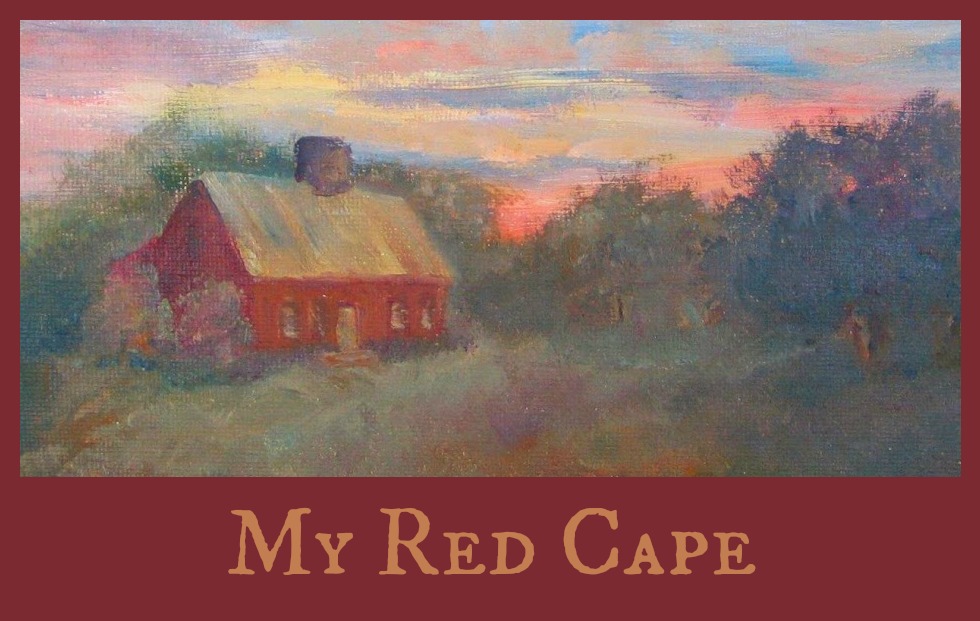Looking at rugs in general, most of them have quiet backgrounds and livelier central motifs. Yes I know red backgrounds are beautiful and they happen! but in general a large part of a rug is neutral or low key in color and just the center of interest has the higher accents. It is possible to have a lot of rug wool at minimum cost by recycling. Some of it can be over dyed to provide more exciting colors. Or that wool can be bought by the yard. A big advantage to dying your own is the intentional color variation of hand dyed wool.
The rooster rug was my first one. The background was made from swatches of three different short coats, and the bodies of the chickens were from a man's heavy dark overcoat. Only the reds had to be purchased of more expensive hand dyed wool which I had not then learned how to make for myself. So most of this rug was made from as is rummage wool.
Colors for the simple whale could be found from rummage wool without hand dying at all. Adding rummage wool to your stash is time well spent for most of us and is fun besides.
Start with closets at home. A good Pendleton plaid skirt may turn up unworn for a year or so. Searching for good 100% wool garments in tag sales or thrift shops is a good next step. Let friends know you are using these things so they will not toss them out when closets are cleaned this spring.
In selecting pieces to buy, blankets are too heavy and thick. Coats often are too. (These items can be used for wool appliqué craft work.) Skirts are better than shirts, because there is less work and larger pieces come from skirts than shirts or Jackets. Jackets are the least to be favored because of the small pieces and more work to take apart. Second to Skirts for me are wool trousers. Do not get worsted found in a lot of wool men's wear. Desirable wool is a medium heavy flannel. Beautiful Pendleton plaids make those shirts with their little darts and many seams still worth having. I do not use pure black. Dark brown or dark grey is as deep a value as I use.
Note here: Why not blends? Why do I say 100% wool only? One reason is the superiority of the wool after you have it in a rug. Another is the inability of many blends to take up the dye evenly. A huge reason is that the cutter blades on a strip cutter will dull in a single session if forced through blends! Never put anything except wool through a conventional strip cutter that has blades. If you have a blended fabric you wish to use, hand cut it with scissors. You will hear and feel the difference when you try to tear the fabric to make usable swatches. The wool says th th softly. The blend says CRICK CRICK ack ack ack harshly. Try it I am not exaggerating.
When other fibers were used in some of our antique rugs, they were hand cut, not put through our expensive little strip cutting machines.
When I bring home rummage wool, I take it straight from the plastic bag to the washing machine. If any slight preparation is needed before washing,
like removing shoulder pads, I do that outside but generally do not like to handle someone's dirty clothing. No chances must be taken that might bring in moths or silver fish bugs. So into the washer it goes, on warm not hot and for a gentle cycle just a short time with normal laundry detergent. Too much agitation or hot water will result in hard felted wool, ruined as far as I am concerned.
Dry the wool with a gentle tumble on low heat and remove when you can and just let it be in the air, fluffy and soft we hope. Now it is time to cut away seams and zippers and hem tape and waist bands, all of that can go in the trash. By snipping along an edge, tear the big pieces of wool and make swatches about 4 inches wide and however long you can. Do not shorten them, the length is desirable. Fold these swatches and stack them in a neat bundle tied with a bit of wool like a seam you have cut off. They are ready now to be pulled out and put through your strip cutter for use in your next project. E


